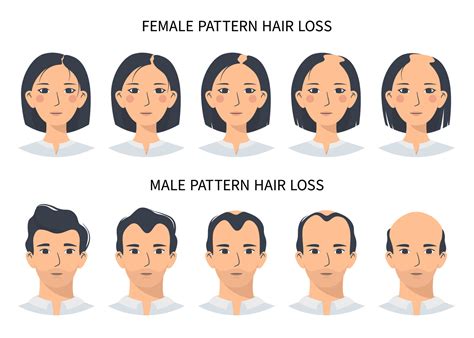Androgenic alopecia, the most common type of hair loss, affects approximately 50% of men and 30% of women by age 50. It typically manifests as gradual thinning of the hair on the crown of the head, which proceeds to the front of the scalp.

Causes of Hair Loss on Top of Head
Androgenic alopecia is caused by a combination of genetic predisposition and the effects of the hormone dihydrotestosterone (DHT). DHT, a derivative of testosterone, binds to receptors on hair follicles, causing them to shrink and eventually cease producing hair.
Symptoms of Hair Loss on Top of Head
The primary symptom of androgenic alopecia is thinning or balding on the top of the head. This process occurs gradually and may be more noticeable in certain lighting. In men, hair loss typically begins at the temples and progresses to the crown, forming an ‘M’ shape. In women, hair loss is more diffuse, with thinning occurring over a wider area.
Risk Factors for Hair Loss on Top of Head
Certain factors increase the risk of developing androgenic alopecia, including:
- Family history: Individuals with a family history of hair loss are more likely to experience it themselves.
- Age: The risk of hair loss increases with age, especially after puberty.
- Genetics: Androgenic alopecia is more common in certain ethnic groups, such as Caucasians and Asians.
- Hormonal imbalances: Androgenic alopecia can be exacerbated by hormonal imbalances, such as those caused by thyroid disorders or polycystic ovary syndrome (PCOS).
Treatment Options for Hair Loss on Top of Head
Various treatment options are available for hair loss on top of the head, including:
Medications
- Minoxidil (Rogaine): A topical solution that stimulates hair growth and slows down hair loss.
- Finasteride (Propecia): An oral medication that blocks the conversion of testosterone to DHT.
Procedures
- Hair transplant: A surgical procedure that involves transplanting hair follicles from the back of the head to the balding area.
- Scalp micropigmentation: A cosmetic procedure that involves injecting ink into the skin of the scalp to create the appearance of hair follicles.
Lifestyle Changes
- Reduce stress: Stress can trigger hair loss.
- Get enough sleep: Lack of sleep can contribute to hair loss.
- Eat a healthy diet: A balanced diet rich in fruits, vegetables, and whole grains may promote hair growth.
Benefits of Treating Hair Loss on Top of Head
Treating hair loss on top of the head can have numerous benefits, including:
- Improved appearance: Hair loss can have a negative impact on self-esteem and confidence. Treatment can restore a more youthful and aesthetic appearance.
- Reduced anxiety and depression: Hair loss can cause anxiety and depression. Treatment can alleviate these symptoms by addressing the underlying cause.
- Enhanced social interactions: Hair loss can hinder social interactions. Treatment can help individuals feel more confident in social situations.
Tips for Preventing Hair Loss on Top of Head
While not all cases of hair loss can be prevented, certain measures may help reduce the risk:
- Maintain a healthy weight: Obesity can increase the production of DHT, contributing to hair loss.
- Avoid smoking: Smoking damages hair follicles and can lead to hair loss.
- Protect hair from sun exposure: The sun’s UV rays can damage hair follicles and contribute to hair loss.
- Use gentle hair care products: Harsh hair care products can damage hair follicles.
Conclusion
Hair loss on top of the head is a common condition that affects millions of people worldwide. Androgenic alopecia is the most common cause, resulting from a combination of genetic predisposition and the effects of DHT. Various treatment options are available, ranging from medications to surgical procedures. Treating hair loss can significantly improve appearance, reduce anxiety and depression, and enhance social interactions.
